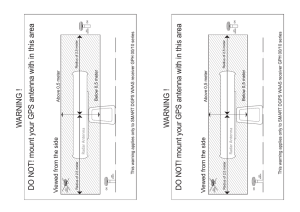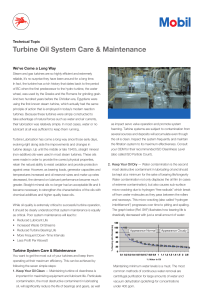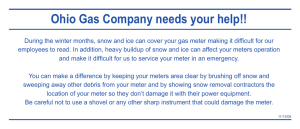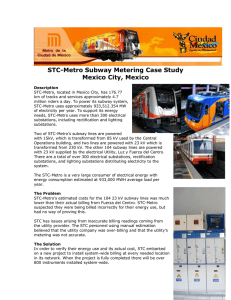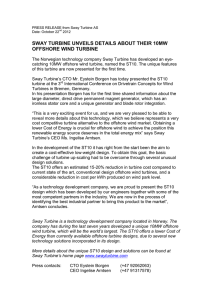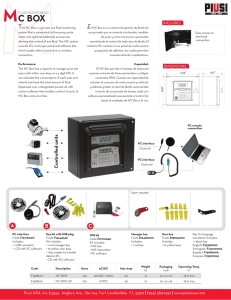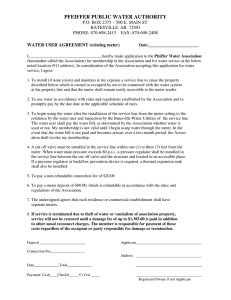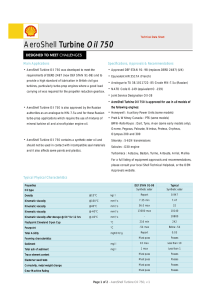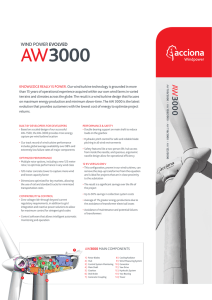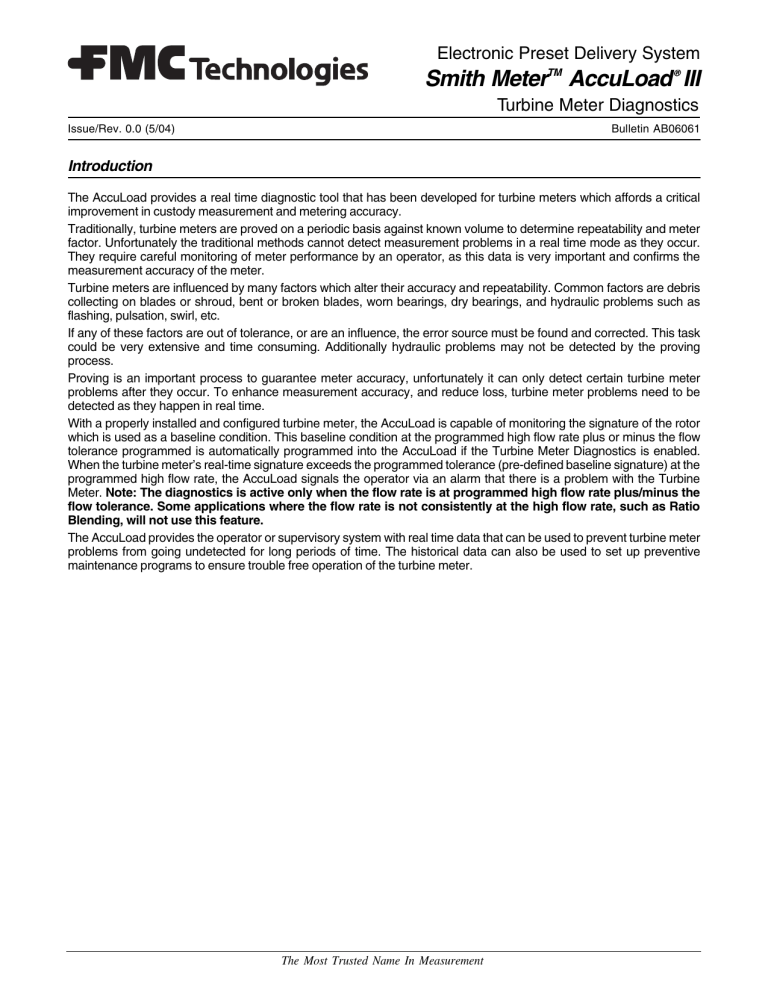
Electronic Preset Delivery System ® Smith MeterTM AccuLoad III Turbine Meter Diagnostics Issue/Rev. 0.0 (5/04) Bulletin AB06061 Introduction The AccuLoad provides a real time diagnostic tool that has been developed for turbine meters which affords a critical improvement in custody measurement and metering accuracy. Traditionally, turbine meters are proved on a periodic basis against known volume to determine repeatability and meter factor. Unfortunately the traditional methods cannot detect measurement problems in a real time mode as they occur. They require careful monitoring of meter performance by an operator, as this data is very important and confirms the measurement accuracy of the meter. Turbine meters are influenced by many factors which alter their accuracy and repeatability. Common factors are debris collecting on blades or shroud, bent or broken blades, worn bearings, dry bearings, and hydraulic problems such as flashing, pulsation, swirl, etc. If any of these factors are out of tolerance, or are an influence, the error source must be found and corrected. This task could be very extensive and time consuming. Additionally hydraulic problems may not be detected by the proving process. Proving is an important process to guarantee meter accuracy, unfortunately it can only detect certain turbine meter problems after they occur. To enhance measurement accuracy, and reduce loss, turbine meter problems need to be detected as they happen in real time. With a properly installed and configured turbine meter, the AccuLoad is capable of monitoring the signature of the rotor which is used as a baseline condition. This baseline condition at the programmed high flow rate plus or minus the flow tolerance programmed is automatically programmed into the AccuLoad if the Turbine Meter Diagnostics is enabled. When the turbine meter’s real-time signature exceeds the programmed tolerance (pre-defined baseline signature) at the programmed high flow rate, the AccuLoad signals the operator via an alarm that there is a problem with the Turbine Meter. Note: The diagnostics is active only when the flow rate is at programmed high flow rate plus/minus the flow tolerance. Some applications where the flow rate is not consistently at the high flow rate, such as Ratio Blending, will not use this feature. The AccuLoad provides the operator or supervisory system with real time data that can be used to prevent turbine meter problems from going undetected for long periods of time. The historical data can also be used to set up preventive maintenance programs to ensure trouble free operation of the turbine meter. The Most Trusted Name In Measurement Theory of Operation Turbine meters are machined accurately to ensure repeatability and performance. The turbine meter signature is not dependent on the product being used. It is controlled by the following factors: the blade’s angle and spacing between each other (linearity), bearing resistance in relation to rotational momentum (meter factor), and hydraulic flow characteristics such as excessive pulsation, flashing and swirl (repeatability). The AccuLoad monitors the pulse rise period ratio, fall period ratio, and the standard deviation. In addition, it monitors the velocity of approach for each blade individually as the turbine meter rotor rotates. The pulsation factor is provided by monitoring the time for one revolution and comparing it to the previous revolution. The AccuLoad monitors the highest error that occurs every second and compares the value to the baseline turbine meter signature. If the error is out of tolerance, then the alarm condition is signaled. Programming The following parameters need to be programmed in the AccuLoad in order to use the Turbine Meter Diagnostic Function. Meter 310 – Number of Turbine Blades This two-digit entry should be programmed to the number of blades/buttons present on the rotor for a turbine type meter. This entry must be programmed accurately if any turbine meter diagnostics are to be performed. It is not used and should be programmed to 0 if the meter is any type other than turbine. The range of this two-digit numerical entry is 0 to 99. Help: Enter the number of blades for turbine meter diagnostics Smith Meter Turbine Meters Model No. K2BA K2BB K2BC K2BD K2BE K2C1 K2CA K2CB K2EA K2EB K2GD K2GE K2SD K2SE K2EA K2EB K2ED K2EE K2PD K2PE K2DR* K2DV* K2DF* K2DW* K2DG* K2DS* K2DH* K2DT* K2DJ* K2DK* K2DL* K2DM* K2DN* No. of Blades Size or Buttons Guardsman 1.5” 6 2” 8 3” Low Flow 14 3” 12 4” 12 Guardsman L and GL 1” 6 1.5” 6 2” 8 1.5” 6 2” 8 3” 12 4” 12 3” 12 4” 12 Guardsman LJ 1.5” 6 2” 8 3” 12 4” 12 3” 14 4” 12 Sentry Series 4” 16 4” High Resolution 24 6” Low Flow 24 6” Low Flow 48 High Resolution 6” 32 6” High Resolution 64 8” 42 8” High Resolution 84 10” 84 12” 68 16” 55 18” 78 20” 103 * Replace D in model number for Din Flanges with M Page 2 • AB06061 Issue/Rev. 0.0 (5/04) Meter 311 – Turbine Meter Diagnostic Tolerance This parameter defines the degree to which the rotor of the turbine meter will be monitored for errors in rotation. The stricter the tolerance, the greater the chance of the turbine meter diagnostic causing an alarm. The factory default is “Most Lax.” Selections are as follows: • (0) Most lax (Approx. 20%) • (1) Lax (Approx 10%) • (2) Normal (Approx. 5%) • (3) Strict (Approx 2%) • (4) Most strict (Approx. 1%) blades on the rotor would be 50 rotations of the rotor).Choose “View Data” from the Turbine Meter Diagnostics display. The current signature will appear, as shown on the screen below. When using the Turbine Meter Diagnostics the Current TMD value is compared to the signature that was obtained in the learn mode. This value is then compared to the signature. Turbine Meter Diagnostics -> Note: No entry if number of turbine blades equals zero Help: The stricter the tolerance, less variation will result in an alarm 642 TM: Turbine Meter Alarm Indicates that the turbine meter signature has changed, and the meter should be examined for rotor problems. This alarm is displayed when the AccuLoad detects a statistically significant variation in rotor rotation in 4 out of 10 updates. Turbine Meter Diagnostics From Turbine Meter Diagnostics, the operator can collect or generate information about a turbine meter, enable or disable the diagnostic, and view information about a meter. With the arrow in front of “Turbine Meter Diagnostics,” press ENTER to display the following screen. Turbine Meter Diagnostics -> Load Arm #1 Load Arm #2 Load Arm #3 Turbine Mtr #1 Turbine Mtr #1 Turbine Mtr #1 Select a Turbine Meter Place the cursor in front of the desired Load Arm, then press ENTER to obtain the following screen. Turbine Meter Diagnostics -> “Begin Learn Mode” signals the AccuLoad to initiate a statistical sampling from which it derives a signature (or numerical profile) and two sub-signatures for the turbine meter (the sub-signatures check the variations in the rows and columns of the data checking for bent blades or missing blades). The signature is gathered at the high flow rate of the meter and is monitored at the high flow rate. The meter signature, as well as a standard deviation for each measurement, is then sent to the KDC board. Before initiating a learn, it is best to record the current signature so the new signature can be voided, if necessary. The diagnostics looks at 300 samples to get a signatures, the number of rotations of the rotor would depend on the number of blades on the turbine meter (I.e. 6 Issue/Rev. 0.0 (5/04) 0.000000e+000 0.000000e+00 Tol: Most Lax A2M1 Disabled – Meter OK Pressing ENTER will toggle the last line of this display from a message like “A2M1 Disabled – Meter OK” to a hex view (e.g., 0x0000). If constantly changing numbers appear at the bottom of the AccuLoad display, the turbine meter diagnostics feature is enabled and is working. (The diagnostic on the AccuLoad runs once a second, and updates the display about once every five seconds.) The AccuLoad counts pulses and flow tolerance. If a statistically significant variation occurs in 4 out of 10 meter turns, an alarm will be generated. The alarm does not necessarily indicate the reason for the variation; possible causes are bearing problems, a bent blade, or flow inconsistency. The error values are proportional to the number of standard deviations away from the signature the values work out to be as follows in percentages; most lax (20%),; Lax (10%), Normal (5%),; Strict (2%); Most Strict (1%). Note selecting a less stringent flow tolerance may correct the problem. If the alarm persists, the meter should be proved. Note: This diagnostic applies to turbine meters only; it is not to be used for positive displacement meters. Choose “Disable/Enable Diagnostic” to disable or enable Learn Mode. The diagnostic toggles between “disabled” and “enabled” every time the screen is selected and exited. Turbine Meter Diagnostics for this meter have been ENABLED Press any key. Begin Learn Mode Disable/Enable Diag View Data A2M1 Disabled – Meter OK Signature Cur TMD Value #Blades: 3 Select “View Data” to display the turbine meter’s signature and current configuration. Turbine Meter Diagnostics -> Signature Cur TMD Value #Blades: 0 0.000000e+000 0.000000e+000 Tol: Most Lax Mtr#1 Disabled – Meter OK Press CLEAR twice to return to the Diagnostics Menu. AB06061 • Page 3 View Turbine Meter Data The Diagnostics menu provides the selection “View Turbine Meter Data” to display turbine meter configuration data. With the arrow in front of “View Turbine Meter Data,” pressing ENTER will display a screen similar to that shown below: Turbine Meter Diagnostics -> Load Load Load Load Arm Arm Arm Arm #1 #2 #3 #4 Meter Meter Meter Meter 1 1 1 1 Select a Turbine Meter Note that the appearance of this screen may deviate from this example, depending on the way the AccuLoad is configured. Position the cursor in front of the desired load arm, then press ENTER to obtain the following screen. Turbine Meter Diagnostics -> Signature Cur TMD Value #Blades: 3 0.000000e+000 0.000000e+00 Tol: Most Lax A1M1 Disabled – Meter OK Press ENTER on this screen to change the status line at the bottom to a hex string (e.g., 0x1001). Press ENTER again to return to the original status line (e.g., A1M1 Disabled – Meter OK). Press CLEAR twice to return to the Dynamic Displays Diagnostics Menu. The specifications contained herein are subject to change without notice and any user of said specifications should verify from the manufacturer that the specifications are currently in effect. Otherwise, the manufacturer assumes no responsibility for the use of specifications which may have been changed and are no longer in effect. Headquarters: 1803 Gears Road, Houston, TX 77067 USA, Phone: 281/260-2190, Fax: 281/260-2191 Gas Measurement Products: Erie, PA USA Phone 814/898-5000 Thetford, England Phone (44) 1842-82-2900 Kongsberg, Norway Phone (47) 32/286-700 Buenos Aires, Argentina Phone 54 (11) 4312-4736 Integrated Measurement Systems: Corpus Christi, TX USA Phone 361/289-3400 Kongsberg, Norway Phone (47) 32/286-700 San Juan, Puerto Rico Phone 787/274-3760 United Arab Emirates, Dubai Phone 971 +4/331-3646 Liquid Measurement Products: Erie, PA USA Phone 814/898-5000 Los Angeles, CA USA Phone 661/702-8660 Slough, England Phone (44) 1753-57-1515 Ellerbek, Germany Phone (49) 4101-3040 Barcelona, Spain Phone (34) 93/201-0989 Moscow, Russia Phone (7) 495/564-8705 Melbourne, Australia Phone (61) 3/9807-2818 Beijing, China Phone (86) 10/6500-2251 Singapore Phone (65) 6861-3011 Chennai, India Phone (91) 44/450-4400 Visit our website at www.fmctechnologies.com Printed in U.S.A. © 2/04 FMC Technologies Measurement Solutions, Inc. All rights reserved. AB06061 Issue/Rev. 0.0 (5/04)
